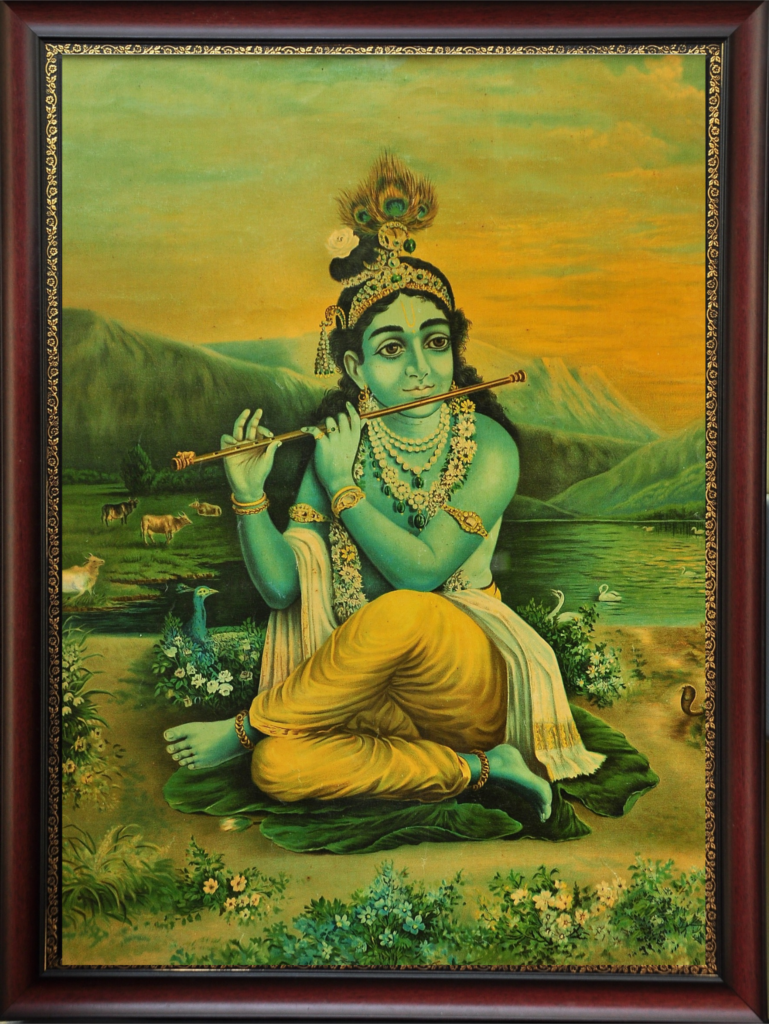Murali Krishna
This stunning painting of Murali Krishna, created by N. Gopala Row as an oil on canvas in 1927, fetched an impressive sum of 60,000 rupees and was printed in Germany , this work set a record for the highest price ever paid for a painting in Indian rupees at that time, a milestone unmatched by any other Indian artist of the period. The elements within the painting reflect the artist’s imagination and deep love for nature. The vibrant colour combinations and intricate details garnered significant recognition for the painter among his contemporaries.
In the artwork, Lord Krishna is depicted seated on a lotus leaf, completely absorbed in playing his flute, surrounded by peacocks, swans, cows, snakes, and mountains, with a pond in the background. The animals are captivated by Krishna’s music, and he revels in the joy of playing. Notably, the intricate detail of a calf at the tip of his flute showcases the artist’s skill. Krishna’s large eyes and exquisite jewelry are rendered beautifully, highlighting the artist’s talent.
The name “Murali Krishna” translates to “Krishna with the flute” in Hindi and Sanskrit, with “Murali” specifically referring to the flute that Krishna is often portrayed playing. This symbolizes his enchanting music, which captivates all beings and embodies divine love and joy. The peacock feather is a constant companion of Lord Krishna, further enhancing his playful and loving nature.
Krishna is often associated with themes of playfulness, love, and spiritual wisdom. His flute music attracts not only the gopis (milkmaids) but also nature itself, underscoring his role as a divine lover and the embodiment of bliss. The image of Murali Krishna beautifully reflects the harmony between the divine and earthly realms, encapsulating his ability to bring joy and transcendental experiences to those who listen to his music.
This particular Murali Krishna painting was oleographed in Germany, similar to other oleographs. However, it is more commonly found adorning the entrances of houses and temples in South India.
Murali Krishna, often simply referred to as Krishna, is a central figure in Hindu mythology and is revered as the eighth avatar of Vishnu. His stories are rich and varied, blending philosophy, devotion, and playful mischief. Here’s an overview of his key tales:
Birth and Early Life
Krishna was born in a prison cell in Mathura to Devaki and Vasudeva. His birth was prophesied to bring about the downfall of the tyrant king Kansa, Devaki’s brother. To protect him, Vasudeva smuggled the newborn Krishna to the village of Gokul, where he was raised by Nanda and Yashoda.
Childhood Adventures
Krishna’s childhood is filled with miraculous deeds and playful exploits. He is known for his love of butter, often stealing it from the homes of the gopis (milkmaids). His playful nature earned him the nickname “Makhan Chor” (butter thief). He also defeated various demons sent by Kansa, including Putana, a shape-shifting witch, and Trinavarta, a whirlwind demon.
Youth and Love
As he grew older, Krishna became famous for his divine love stories, particularly with Radha, his beloved. Their relationship symbolizes the soul’s yearning for the divine. The Raas Leela, a dance performed by Krishna with the gopis, is a celebration of this love and devotion.
The Mahabharata and Bhagavad Gita
Krishna plays a crucial role in the Mahabharata as a friend and charioteer to Arjuna. During the great Kurukshetra war, he imparts the teachings of the Bhagavad Gita, addressing Arjuna’s doubts about duty, righteousness, and the nature of the self. This text is one of the most important scriptures in Hindu philosophy.
Teachings and Philosophy
Krishna’s teachings emphasize dharma (righteousness), bhakti (devotion), and the importance of surrendering to the divine will. His life embodies the principles of love, compassion, and selfless service.
Conclusion
Krishna’s stories continue to inspire millions, celebrating the divine play (lila) and the profound truths of existence. He is worshipped in various forms across India and beyond, symbolizing love, joy, and the ultimate truth. His legacy endures through festivals, art, and spiritual practices, making him one of the most beloved deities in Hinduism.

